
Newsletter of the Shell Club of Sydney
NSW Branch, The Malacological Society of Australasia Limited ACN 067 894 848
September minutes:
Meeting opened by P. Jansen at 2.15 pm after the group changed rooms.
Apologies:- M. Keats, S. Montague and D. Beechey.
Field Trip Reports
R. Moylan reported on a trip to the Barrier reef, north of Swains reef. Ron encountered a number of volutes including
Cymbiola pulchra forma peristicta (Mc Michael, 1963) and
Cymbiola pulchra forma woolacttae (Mc Michael, 1958). Ron also reported finding most of the common Cypraeidae at Lamonte reef and added that the water temperature was unusually cool.
C. Barnes reported collecting Strombus canarium Linnaeus, 1758 beached at Long Bay, Sydney. Chris also reported on a visit to Yamba and Illuka and passed around a tray of specimens collected, including a
Cypraea lynx Linnaeus 1758 and Bursa granularis (Roding, 1798) .
A. Hawke displayed a number of interesting specimens from the south coast of NSW and Victoria, these included an example of
Fusinus consetti Iredale, 1929. Angus also passed around some specimens collected from northern NSW during last Christmas.
General Business
M. Keats reported via P. Jansen that he had been in touch with Rupert Myers. Io's shell collection, minus a couple of family favourites is to be auctioned off at the November meeting, and monies raised to be donated to the group. J. Franklin has resigned from the E- council, C. Barnes offered to do the job and was unanimously accepted. Letter from Phillipa Menzies (Grade 4 student) possible new member. M. Keats has already responded, though a copy of the latest "Sheller" and annual shell show flier will be dispatched by the secretary.
Presentation
The Family Turbinidae, by M. Keats was this months presentation, though as Michael was unable to attend the meeting, C. Barnes filled in. Fortunately Michael had prepared a handout and arranged specimens of the various subfamilies to display to the meeting.
Meeting closed at 3.07 pm
C. & K. Barnes, Secretary
SHELL SHOW PLACING
SATURDAY 26 OCTOBER 2002
| Category |
Placing |
Exhibitor |
| Display of Bivalvia |
First
Second
Third |
Steve Dean
Patty Jansen
John Franklin |
| Display of Conidae |
First
Second
Third |
Steve Dean
John Franklin
Steve Dean |
| Display of Cypraea |
First
Second
Third |
Ron Moylan
Chris Barnes
John Franklin |
| Display of Land Snails |
First |
Michael Keats |
| Display of Micro Shells |
First
Second
Third |
John Franklin
Sandra Montague
Patty Jansen |
| Display of Olividaea |
First
Second |
Chris Barnes
John Franklin |
| Display of Muricidae |
First
Second |
Ron Moylan
John Franklin |
| Display of Self Collected Shells |
First
Second
Third |
Chris Barnes
Sandra Montague
John Franklin |
| Display of Shells from one locality |
First
Second
Third |
Ron Moylan
Ashley Miskelly
Patty Jansen |
| Display of Volutidae |
First
Second
Third |
Ron Moylan
John Franklin
Peter Piener |
| Display of Any Family predominantly white |
First
Second
Third |
Maureen Anderson
Steve Dean
Patty Jansen |
| Display of Bivalvia |
First |
Chris Barnes |
SHELL SHOW OVERVIEW
This years Shell Show included 47 exhibits by 10 Club Members. (Pictures of some of the exhibits follow)
All entries exhibited an excellent standard of material for the respective categories and a great deal of time and effort apparent with the presentation and data information provided.
Some entries exceeded the maximum numbers of specimens permitted and this must be carefully monitored for future Branch and indeed National Shows as demerits apply which will compromise the possible placings for such an oversight.
The standard of the entries made the judges decisions extremely difficult with only a point the difference between placings in some categories.
It is suggested that for future Shows a standardisation of exhibit footprint sizes be established, albeit unnecessary to present each display in the same material, however an overall uniformity is desirable and essential for the most economical utilisation of display area available.
Shell of the Show was a superb specimen of Bursa granularis live taken by Chris Barnes at Angourie Point northern NSW at low tide, amongst rocks with sponge and algae
covering:
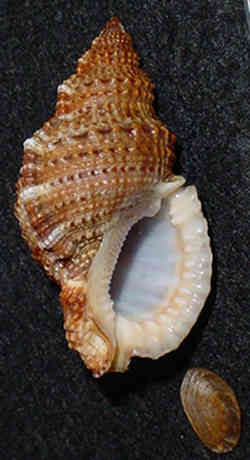
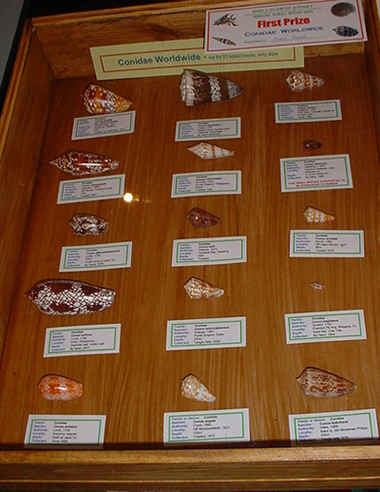
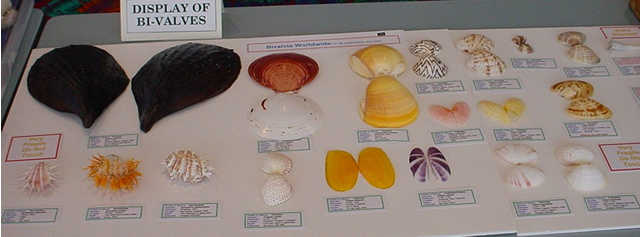
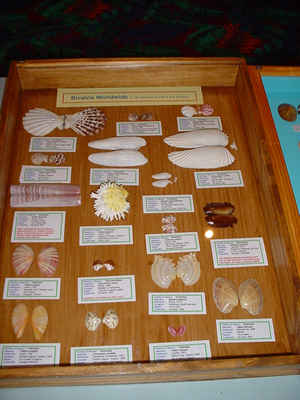
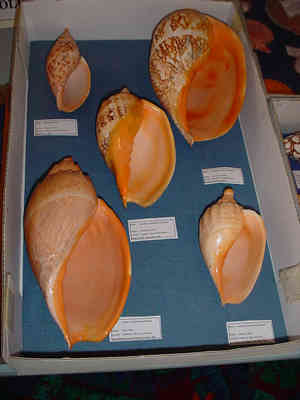
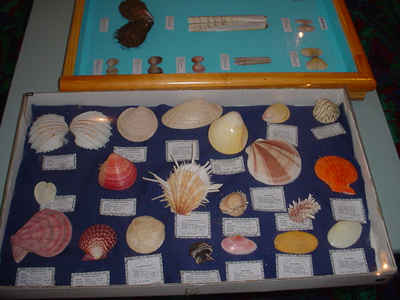
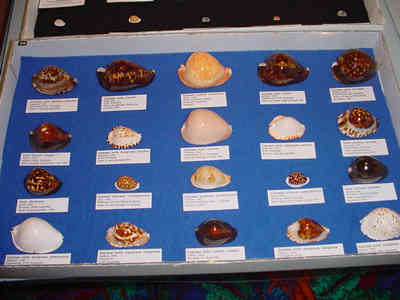
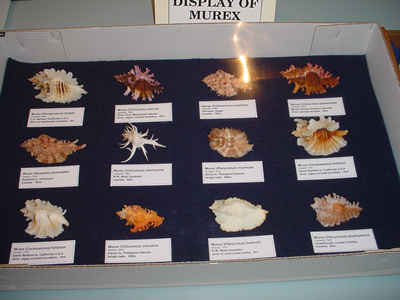
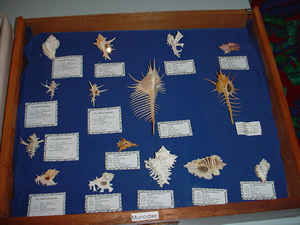
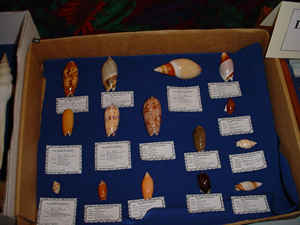
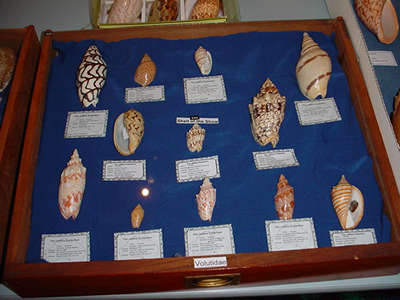
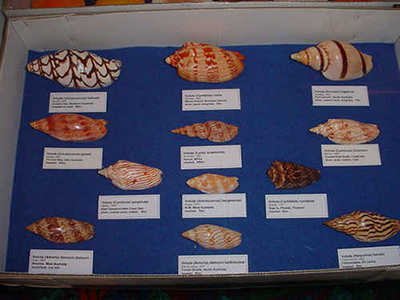
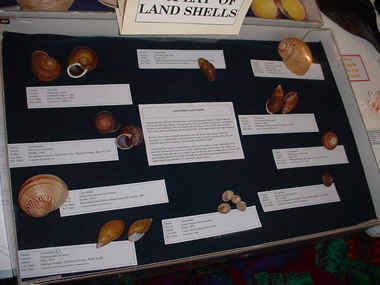
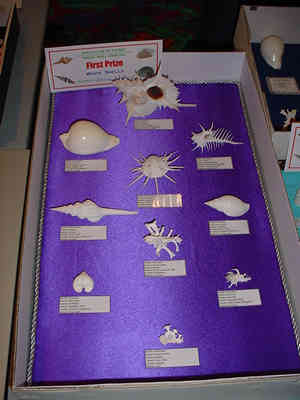
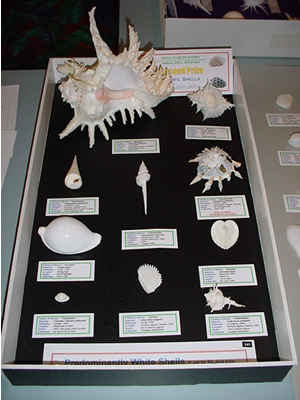
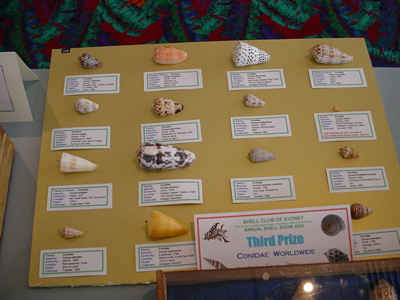
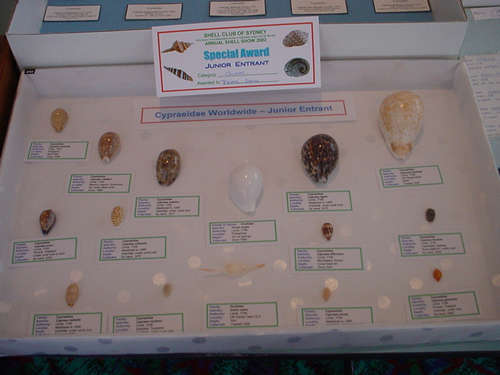
Junior Entrant
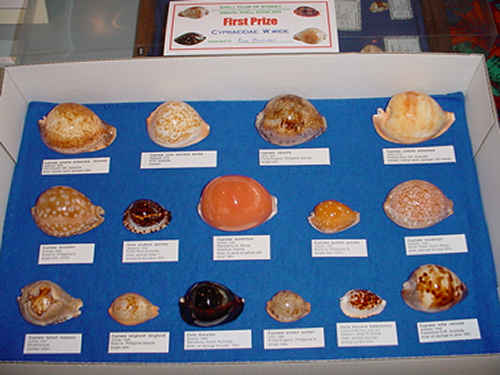
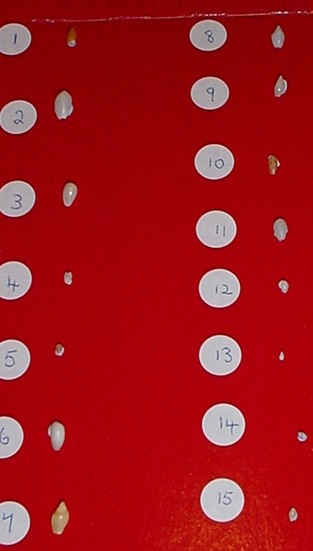
Land Snail Collecting on Phillip Island
By Michael Keats
This Phillip Island is not the location of the popular motor racing circuit. It is a namesake island located some 6 kilometres south of Norfolk Island in the South Pacific Ocean. For those interested in exact data, the centre of the island land mass is 20 degrees and 7 minutes south and 167 degrees and 57 minutes east. My wife Jenny and I visited Norfolk Island during July 2002.
According to the locals neither Norfolk or Phillip Islands have any land snail species. The land snail species that I found may be a human import but I think it is unlikely. Let me now however tell you the story of the find.
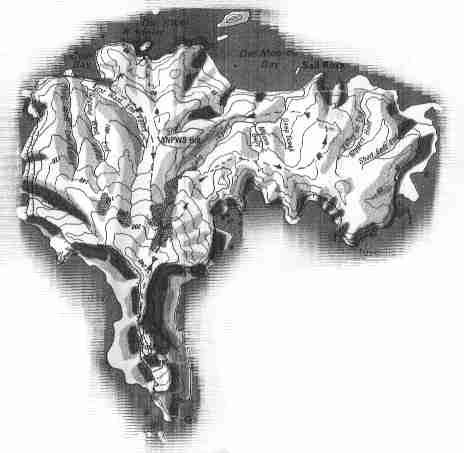
The highest point of the island is Jacky Jacky Ridge, which rises some 280 m. It is also close to Garnet Point, the southern most tip of the island. Drainage
includes 8 dry river valleys that with one exception all grade from south to north. The island is difficult of access with the western, southern and eastern aspects presenting towering precipitous cliffs rising shear from the ocean. Access from the northern side is possible via a very risky jump from a vessel and an abseil!
In area the island is approximately 190 hectares. Geologically the rocks (all volcanic) are Late Tertiary (about 3 million years). The island is possibly part of a much older and larger caldera that includes Norfolk Island.
The island was named in 1789 after Governor Phillip, then Governor of NSW. When Norfolk Island was being used as a penal settlement, Phillip Island was 'used' as a place to keep game for the Officers. It was stocked with black angora rabbits, goats and pigs! This combination of exotic stock changed the island forever. In a few short years the island was almost completely denuded of all vegetation and erosion of the deep decaying volcanic tuffs and pyroclastics has resulted in metres of top soil loss. In some areas this can be seen in mature Norfolk Island pine trees
(Araucaria heterophylla) with root systems 2 to 3 metres above the current ground level. The last rabbit was not removed until the 1980's
A 'walk' on the island is a unique experience. It combines adrenalin, abseiling, bushwalking (without bush!), stupendous views, amazing migratory birds, unbelievable colours, endemic plants and a sense of unreality. It was a very personal walk. There were 3 of us in the party - our guide Kaleen, a native born Norfolk Islander, Colin a former teacher based on Norfolk Island for 3 years seventeen years ago and back for a nostalgia visit and yours truly.
Our walk was preceded by an ocean circumnavigation travelling east to west from the Dar Stool Inlet (the recommended 'landing point'). With a 3 metre swell running, and the desire of the skipper to show all his skills as well as his knowledge, this trip left me transfixed and a whole roll of film used just for the circuit!
The view from the sea to Jacky Jacky Ridge at Garnet Point cannot be properly captured in one picture. It simply will not fit! The greatest adrenalin rush came from an unscheduled visit into a sea cave (possibly a collapsed lava tunnel). I can only liken it to taking a suicide mission inside the Blow Hole at Kiama. The surge, the inky blackness, the thump of the waves on the back wall, the rotating horizon, the compression of air and finally the suction back out into the ocean. Thank heavens the 200 horsepower outboard did not miss a beat.
The skipper, Mike Simpson did not hang around. After he had seen us on to the rocks at Dar Stool Inlet he returned to Kingston. Kaleen called him on the two way when we needed the return trip. To add a bit more to the days experience, nature turned on some rain and an easterly gale as we completed our trek. The decaying volcanics when wet become glassy smooth and residual pieces of rock act as ball bearings. There is a point after the rain starts when the only way to move is on your bum! Otherwise you are flat on your face! Kaleen's timing was perfect. We reached the abseil descent minutes before the 'bum' mode of movement was essential.
Being a keen photographer was both a blessing and a curse. A blessing because 5 rolls of film just went so quickly. A curse because the camera pushed me to the limits of my adrenalin capacity and physical capability to get that special shot. Many times! Some of my prized shots are of courting Masked Boobies, The endemic Phillip Island Gecko and flowers of the rare and endangered Phillip Island Hibiscus. The pictures of the red, pink, mauve, yellow and gold landscapes have viewers in disbelief.
Up on the top of Jacky Jacky Ridge there is something less than 3 metres by 2 metres to stand on. The vegetation that survives there is stunted and windswept. Success taking pictures or land snailing is more than an effort. It is a miracle! When I planned to visit the island the last thought I had was land snailing.
Given the history of destruction of the vegetation and the presence now of an untrammelled population of the endemic geckos and tens of thousands of migratory birds each year I though the presence of any land snails would be highly unlikely. Imagine my surprise when sitting down to change films on the top of Jacky Jacky Ridge that I saw a snail! I was so surprised for a moment that I did not believe it. After recovery I was able to find 6 dead specimens. They appear to be Meridolum sp. I have handed them over to Stephanie Clark who is undertaking major research with this group in NSW. Administratively at least Norfolk and Phillip Islands are part of NSW.

I await with interest Stephanie's assessment of the material.
If you ever have the opportunity to visit this Phillip Island and you are fit and agile, do it. It is an experience you will never ever forget.
|





















